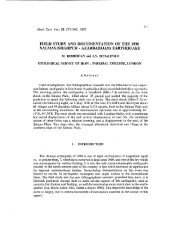PDF COPY - Manuel berberian
PDF COPY - Manuel berberian
PDF COPY - Manuel berberian
You also want an ePaper? Increase the reach of your titles
YUMPU automatically turns print PDFs into web optimized ePapers that Google loves.
ment of the Dasht-e-Bayaz fault and caused surface<br />
58100 ~, . 59100 ~ L 5~ I<br />
ruptures associated with the 1979.11.27 (Ms=6.6)<br />
~ oGonabad<br />
m= earthquake [Haghlpour and ~midi 1980].<br />
~eismic Creep And Interselsmlc Stage<br />
aftershock occurrence. The Dasht-e-Bayaz E-W<br />
fault is terminated at both ends by major NW-SE<br />
structures transverse to the strike of the fault<br />
(Figs. 4 and 5). The fault-blocks, produced<br />
these faults, could be partially decoupled from<br />
each otherand therefore might have moved without<br />
major internal deformation. It seems that after a<br />
considerable lateral motion and relative westward<br />
movement of the northern block, the Ferdows<br />
frontal reverse fault in the west, served as a<br />
location for high stress concentration [Berberlan<br />
1979a]. Similarly, the 1979.11.14 earthquake<br />
(Ms=7.1) and its aftershocks along the Abiz fault<br />
(Fig. 5 and Table I), triggered the eastern seg-<br />
Ferdow<br />
~" -3"~.00 Vnlike oceanic plate boundaries, the sum of the<br />
J<br />
displacements determined from seismic moment in<br />
Iran is very much less than the rate of plate<br />
interaction estimated on a long-term basis from<br />
sea floor magnetic lineaments [North 1974, 1977].<br />
This may imply that seismic faulting is not the<br />
primary deformation and a substantlal portlon of<br />
deformation is taken up aselsmlcally by fault<br />
0 . . . 4.0km creep, beddlng-plane sllp or other forms of<br />
ductile deformation. Since the contlnental<br />
deformation along the convergent zones is<br />
Fig. 8. Reactivation of the Ferdows distributed and controlled by velocity boundary<br />
frontal reverse fault during the largest condltlons of plate interactions described by the<br />
aftershock of the 1968 Dasht-e-Baya z<br />
earthquake with silks-slip faulting. Dashte-Bayaz<br />
earthquake fault associated with<br />
the main shock of magnitude Ms=7.5 had a<br />
plate tectonics theory, the contlnental faults<br />
would posslbly reactivate and move at slower rates<br />
than the plate rates. No evidence of fault creep<br />
has been documented so far along the faults in<br />
vertical left-lateral mechanism striking<br />
E-W [Ambraseys and Tchalenko 1969,<br />
Tchalenko and Berberlan 1975]. After 20<br />
hours the readjustment of the local stress<br />
system triggered a shock of magnitude<br />
Ms=6.3, 60 km west of the main shock damage<br />
zone. Left-lateral strlke-sllp motion on<br />
the northern block along the Dasht-e-Bayaz<br />
fault (arrow) produced compression at its<br />
western boundary near the Ferdows frontal<br />
reverse fault and reactivated the latter<br />
[Berberlan 1979a]. Stlppled areas are the<br />
eplcentral regions of the large magnitude<br />
earthquakes. Transverse Mercator ProJectldn.<br />
Inset top right: Relocated epleentres of<br />
1968 teleselsmleally recorded earthquakes<br />
relatlve to the 1968.09.01 earthquake which<br />
4430 4&45 4500<br />
38.15<br />
was used as master event [Jackson and Fitch<br />
1979]. The relocatlon pattern is positioned I ~ ~I 9 5 1.0 1.5 km<br />
here by siting the earthquakes relative to<br />
3800<br />
the dips of the Dasht-e-Bayaz (hlgh-angle<br />
reverse dipping north with major leftlateral<br />
strlke-sllp component) and the<br />
Ferdows (frontal thrust dipping ME) faults.<br />
52 BERBERIAN<br />
Fig. 9. Reactivation of the ~ekaryazl<br />
reverse fault during the largest aftershock<br />
of the 19~0 Salmas earthquake. The Salmas<br />
earthquake fault associated with the mainshock<br />
of magnitude Ms=7.4 had a rightlateral<br />
dlsplacement and normal mechanism<br />
at the surface. Ground displacements<br />
associated with this earthquake were<br />
interpreted In terms of a regional extension<br />
and east-northeastward motion of<br />
crustal material (arrow) [Tchalenko and<br />
Berberlan ~974, Berberlan and Tchalenko<br />
~976c]. After 41 hours, the readjustment of<br />
the local stress system triggered the<br />
largest shock of magnitude Ns=6.2 along the<br />
~ekaryazi reverse fault about 30 km<br />
northeast of the main-shock eplcentral zone<br />
[Berberlan 1979a]. Intensities are on the<br />
Modified Mercalll scale. Transverse<br />
Mercator ProJection.







